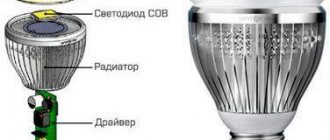Some people, having heard all sorts of horrors about power supplies, controllers, dimmers and other additional devices, refuse to purchase an LED lamp at all. The reason for this is the “increased” price tag. If only they knew about the 220 V LED strip. This is a special device that does not require a power supply to convert the power to the required level. The device is powered from a full mains voltage of 220 Volts. A controller is also not needed for this device if the owner does not need to adjust the brightness and color program. The colors are switched using a button on the rectifier, which makes using the LED strip much easier.
Types of LED strips for 220 V.
The modern market of LED devices offers 2 types of 220 V LED strip:
- With rectifier;
The rectifier is built into the LED strip itself.
- without rectifier.
It is connected separately.
Both options are divided into lengths that are multiples of 50 centimeters or 1 meter. This rule occurs due to one production feature: there are 60 LEDs on each section of the device. Therefore, it is impossible to cut off 25 centimeters or 2.3 meters, respectively, 30 and about 270 LEDs.
LED strip 220 V differences in the color of the glow.
Different ribbons can play different shades. Some devices can reproduce all the colors of the rainbow, while others specialize in only one. So, classification by color:
- single-color (monochrome);
- multicolor (RGB).
Brightness adjustment.
To change the intensity of the glow and set the program for changing shades, you need to get a special controller, which is difficult to buy separately from the tape itself. You can also change the brightness level using a dimmer, but this device will not be able to influence the change in colors and the dynamics of their play.
Features of 220 V LED strip.
To operate this tape, as already mentioned, you do not need a voltage stabilization unit. But it should be noted that the mains voltage fluctuates between 190 and 240 V, and the device needs exactly 220 V for full and safe operation. The brightness of the lighting directly depends on the number of volts received: the more volts there are, the brighter the device shines, and vice versa. It would seem that what’s wrong with this, it’s shining, and it’s shining. But a line that constantly receives 240 V will last significantly less than its intended life. Otherwise, if there is insufficient voltage, of course, the device will live longer, but the lighting will also be dimmer. If the power supply is unstable, the best solution would be to purchase a power supply. It will normalize the operation of the device and maintain the network voltage at the optimal level: 220 Volts.
The main differences between types of devices:
- features of functioning;
- appearance;
- possible lengths of segments into which the tape can be divided.
Connection diagram for LED strip via power supply
In order for a 12-volt LED strip to operate stably for many years, it must be connected to a switching power supply with an output voltage of 12 V. This is the most correct option - switching power supplies are light in weight and compact in size, have high efficiency and stabilization coefficient, and are also safe in operation. Disadvantages include the generation of impulse noise sent back to the network and the complexity of the circuit, which requires special skills to repair.
An article on choosing a power supply for an LED strip will help you make the right decision in favor of one power source or another.
Up to 5 meters
Very often, ordinary users are interested in the question of how to connect an LED strip up to 5 meters long? Everything is very simple here. Just use the diagram below. The connection procedure is performed in the following sequence:
- using a connector or by soldering, connect 2 supply wires with a cross-section of 1-1.5 mm2 to one of the ends of the tape;
- the free ends of these wires are clamped into the corresponding terminals of the power supply (+V, -V), observing the polarity;
- A network cable is connected to terminals L and N (220V AC).
In a similar way, parallel connection of several segments to one power supply is performed. The main thing is that the power of the power supply is at least 30% greater than the total power of the connected LED strip.
To ensure that the brightness of the LEDs is uniform along the entire length of the LED strip, it is recommended to connect wires from both ends to sections longer than 4 meters. This is due to a voltage drop on the current-carrying printed conductors (tracks), as a result of which the furthest LEDs receive a voltage of less than 12 V and their brightness decreases. The advantage of this method is a uniform glow, and the disadvantage is the cost of additional wires.
Over 5 meters
The fact that the length of the LED strip in a reel is limited to 5 meters is not an accident, but a forced technological measure. The fact is that the conductive tracks glued along the tape are very thin, narrow, and are designed to connect a certain number of LEDs. It is for this reason that 2 sections with a total length of more than 5 meters cannot be connected in series. To avoid current overloads, connecting LED strips 10, 15 and even 20 meters long should be done according to one of the diagrams below. The first option involves the use of one high-power power supply capable of providing a current of up to 20 A to the load. To ensure uniform illumination of the LEDs, the supply voltage is supplied to each of the 5 meter segments from both sides. In the second option, each segment is powered from a separate 12V source. Implementing this circuit is a little more difficult, since you will need another power supply and more connecting wires. In the third diagram, in addition to two 12 V DC voltage sources, a dimmer and a single-channel signal amplifier are added to the circuit. The dimmer is used to adjust the brightness of the light flux. The task of the signal amplifier is to exactly duplicate the signal from the dimmer for those LED strips that are powered from the second power supply.
The considered methods of switching on LED strips are typical, but their variations can be used to develop more complex circuits in order to implement certain tasks or meet customer requirements.
Connecting RGB or RGBW LED strips
The connection rules and features mentioned above must also be observed when installing multi-color analogues. However, functional diagrams with RGB and RGBW strips will look a little more complicated due to the appearance of a controller and additional wires. The RGB/RGBW controller significantly expands the capabilities of the lighting system by dimming individual colors, creating lighting effects and control from the remote control (RC). The RGB/RGBW controller is designed for connecting multicolor strips with separately located white LEDs, which allows you to use such a system not only as an additional one, but also as the main light source in the room.
For the convenience of readers, all basic diagrams, installation rules, examples and nuances of switching on multicolor strips are collected in a separate article about connection diagrams for LED RGB and RGBW strips.
Application of 220 V LED strip
Businessmen often use LEDs for outdoor advertising: billboards, banners, signs and other ways to attract customers. Successful entrepreneurs are serious people who won't buy a bad product. LED lighting has earned trust in its ease of use, reliability, efficiency and long service life. The relatively low cost also played an important role, which decreased due to operation from a 220 network. The once mandatory power supply was removed from the entire structure, leaving only a diode bridge.
Due to the absence of a stabilizing unit, the tape voltage is pulsed with a frequency of 60 Hz, which contributes to the blinking of the diodes. The human eye does not see the altered glow, but the central nervous system and brain suffer from a similar phenomenon. Therefore, it is not recommended to decorate rooms where people are constantly present. For example, for a residential building, a 12 and 24 V tape is more suitable. There is an option to simply add a power supply for the 220 device, which will normalize all processes and protect the health of people and the device itself.
Thus, if a person wants to save money and not worsen his well-being, he will not be able to do this with an option that runs on 220V. For proper functioning you need to purchase certain parts. Of course, you can do without them, but on the condition that people are not constantly near the tape.
Tape supply voltage
The main parameter of LED strips is the supply voltage. Of course, it is different from what we have in our outlets. Based on voltage, tapes are divided into three groups:
- Power supply 12 V.
- Power supply 24 V.
- Power supply 36 V.
Moreover, the current must be constant! If you plug the tape into the network without a power supply, it will fail. The unit voltage must be appropriate - 12, 24, 36 Volts. With its help, the mains voltage is reduced to the operating value. The most popular models of LED strips operate at a voltage of 12 V. Therefore, you need to choose only those LED strip power supply circuits that can generate such voltage.
Advantages and disadvantages of 220 V LED strips.
So, having familiarized ourselves with all the nuances of popular lighting, we can highlight all the good and bad sides.
Pros:
- no need for a power supply;
- compactness of additional devices;
The straightener fits completely in your pocket.
- low current strength;
By using thin wires instead of thick ones, money is saved and installation time is reduced.
- functionality and practicality;
- strength;
The device is resistant to external influences: rain, frost, strong wind. Therefore, it can be used as street lighting.
- length up to 200 meters in one piece.
Minuses:
- undesirability of use in a crowded place due to flickering;
- impossibility of repair;
If the device is damaged, it cannot be repaired. You will have to buy a new one, which will significantly affect the budget.
- it is possible that harm will occur to a person during installation due to high voltage;
- Certain conditions for dividing the tape are not always comfortable for owners.
How to connect an LED strip to 220 V.
The connection process is quite simple - you need to connect several wires, taking into account the polarity.
Algorithm of actions:
- We cut the required piece of strip into 50 or 100 centimeters - you need to check the instructions or on the manufacturer’s website.
- When using the sealed version, apply sealant to the end and put on a silicone connector.
- We install the connector and secure it with sealant.
- We connect the strip to the rectifier, observing the polarity.
- We check for tightness and for the absence of moisture inside.
- We mount the tape into the required surface and plug it into a power outlet.
Power supply assembly process
You have an LED strip in stock, the power supply has been calculated and the elements have been selected, now you can begin assembly. Both printed and wall-mounted installations are allowed.
Of course, the whole structure will look much more attractive on a printed circuit board. The manufacturing process looks like this:
- The diodes are connected to each other using a bridge circuit. Be sure to observe polarity; all diodes have an anode (positive terminal) on the strip side of the body.
- Connect the secondary winding of the transformer to the diode bridge.
- An electrolytic capacitor must be connected to the bridge output. When connecting, you must observe polarity! Otherwise the capacitor may explode!
- A choke is connected to the positive terminal gap.
- Next, a zener diode is switched between plus and minus. After it, it is also advisable to install another capacitor.
Finally, the entire device is assembled into one housing, the elements are securely fastened and two outlets are made. The red wire should indicate the positive terminal, black or blue the negative terminal. At this point, the production of the power supply for 12 Volt LED strips is completed, you can use the device.











